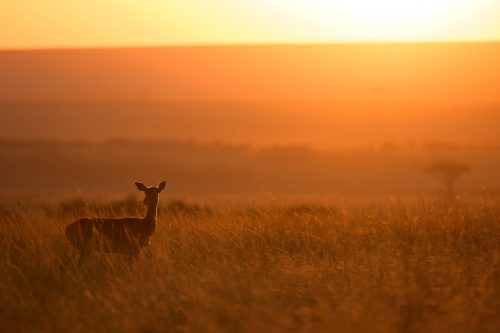For enthusiasts of birdwatching, Kimana Sanctuary stands as a habitat teeming with a remarkable variety of bird species. One might find themselves engrossed in a single spot, much like I did, observing and capturing images of the vibrant white-fronted bee-eaters. These birds showcase a stunning palette of colours, including green, white, red, blue, black and orange. When in flight, they assert their dominance in the sky as they skilfully catch their prey.
Their diet is primarily made of bees, but they also eat other flying insects depending on the season and availability of prey. They make quick hawk-like flights or glide from lower branches of shrubs and trees and hover briefly to catch insects. Once the prey has been snatched out of the air the bee-eater finds its perch and begins the ‘de-stinging’ process by squeezing the insect to discard its poison and then hitting it against the perch to remove the sting.
This week, I came across another captivating bird, the African pygmy falcon; a petite raptor indigenous to eastern and southern Africa. Notably, the pygmy falcon is the smallest bird of prey on the African continent and is among the tiniest raptors globally. Female pygmy falcons exhibit a brown back, while males sport a grey one. Intriguingly, these falcons choose to breed in the nests of sociable weavers or buffalo weavers.
With the onset of rains, the Sanctuary experiences a surge in insect density, creating a feast for the resident birds. Among them, the lilac-breasted roller stands out, employing a similar strategy as the bee-eater when dealing with large bees.
The river coursing through Kimana Sanctuary offers a glimpse into the fascinating world of insects, such as the damselfly, which shares similarities with the dragonfly but is smaller and boasts a more slender physique. During copulation, the male damselfly takes the lead by grasping the female behind her head using specialised appendages located at the end of his abdomen. What sets this process apart is the male's need to transfer sperm from their primary genitalia, situated toward the end of their abdomen, to their secondary or accessory genitalia, positioned near the front. Remarkably, this transfer occurs even while the male continues to clasp the female with the end of his abdomen.
If receptive, she swings her genital opening, situated towards the tip of the abdomen underside, into contact with the male’s accessory organ. The sperm can be transferred in flight or at rest, whilst both are in this circular, wheel-like position. Before the transfer, the male first removes any sperm that the female might have already received. Afterwards, he will guard the female from rivals while she lays her eggs. - Robert Sayialel
The beauty of the Mara shines all year round but it shines the most in the rainy seasons; the month of December is a season of 'short rains' and is as green as it gets. The term 'short rains', is a farming phrase referring to the length of the season and not the amount of rain received. We have been receiving a fantastic amount of rain in short downpours — transforming the landscape into lush green with an abundance of water and wildlife.
The Angama lioness has recently been spotted out and about with her two cubs. Watched by curious onlookers; she seems to be orienting the cubs, getting them familiar with her territory. The cubs are growing up healthy and are often seen playing with each other. The lioness is still in the company of the two males just below Angama Mara and we hope that they will stick around to form a coalition. This will mean they'll be much stronger and hopefully, we will see the rebirth of the Angama Pride.
As adept climbers, leopards are often spotted lounging on tree branches; their arboreal skills make them highly adaptable predators in a variety of landscapes. Angama Guide, Titus, captured a lone female perched in a tree close to the border this week. The branches serve multiple purposes for these cats — either a watch tower for safety, scouting for prey and protecting their kills by dragging them up to keep away from scavengers. - Joseph Njenga
Filed under: This Week at Angama
Subscribe for Weekly Stories
Comments (0):

Rates & Availability